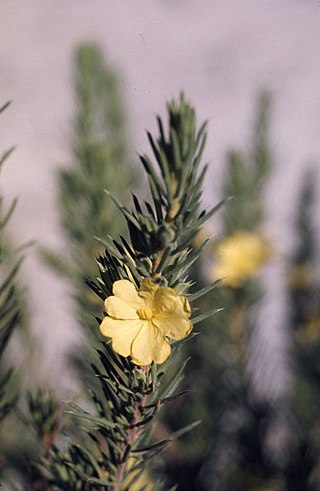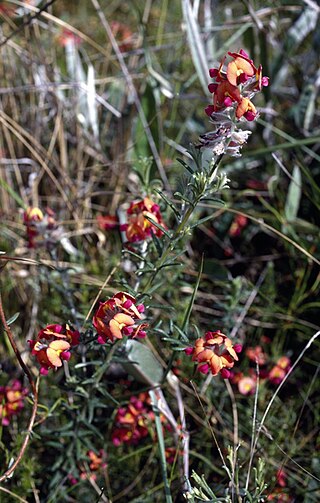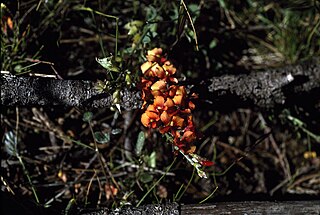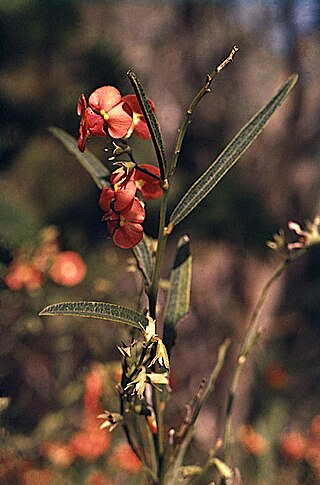
Dillwynia uncinata, commonly known as silky parrot-pea, is a species of flowering plant in the family Fabaceae and is endemic to southern Australia. It is an erect, spreading shrub with cylindrical leaves and yellow flowers with a red centre.
Pultenaea adunca is a species of flowering plant in the family Fabaceae and is endemic to the south of Western Australia. It is an erect, spindly shrub with hairy, needle-shaped leaves and yellow and red flowers.
Pultenaea brachyphylla is a species of flowering plant in the family Fabaceae and is endemic to the south of Western Australia. It is an erect, spindly shrub with cylindrical, grooved leaves and yellow, orange and brown flowers.

Hibbertia mucronata is a species of flowering plant in the family Dilleniaceae and is endemic to the south of Western Australia. It is an erect shrub with hairy branches, crowded, thick, tapering linear leaves ending in a sharp point, and golden yellow flowers with five stamens fused at their bases, all on one side of two densely hairy carpels.
Bossiaea divaricata is a species of flowering plant in the family Fabaceae and is endemic to the southwest of Western Australia. It is a low, dense, openly-branched shrub with oblong to egg-shaped leaves and deep yellow and dark red flowers.
Pultenaea rotundifolia is a species of flowering plant in the family Fabaceae and is endemic to the south of Western Australia. It is a straggling, spreading shrub with flat, glabrous leaves, and yellow flowers with red markings.
Pultenaea spinulosa is a species of flowering plant in the family Fabaceae and is endemic to the south of Western Australia. It is a shrub with flat, hairy leaves, and uniformly yellow flowers.
Hibbertia verrucosa is a species of flowering plant in the family Dilleniaceae and is endemic to the south-west of Western Australia. It is a shrub with scattered, densely hairy, narrowly rectangular leaves and yellow flowers usually with ten stamens fused at the bases, all on one side of two densely softly-hairy carpels.

Lasiopetalum quinquenervium is a species of flowering plant in the family Malvaceae and is endemic to the south of Western Australia. It is an erect, spreading shrub with hairy stems and leaves, egg-shaped leaves and pink or white flowers.

Lasiopetalum rosmarinifolium is a species of flowering plant in the family Malvaceae and is endemic to the south-west of Western Australia. It is an erect or spreading shrub with hairy stems and leaves, linear leaves and white flowers.
Olearia imbricata, commonly known as imbricate daisy bush, is a species of flowering plant in the family Asteraceae and is endemic to the south-west of Western Australia. It is a shrub with small, overlapping linear leaves and bluish-purple or white, daisy-like inflorescences.

Spyridium cordatum is a species of flowering plant in the family Rhamnaceae and is endemic to the south-west of Western Australia. It is a prostrate, straggling or ascending shrub with leathery, broadly heart-shaped leaves with a notched tip, 2–4 mm (0.079–0.157 in) long with woolly, white or rust-coloured hairs on the lower side. The heads of flowers are 6.5–8.5 mm (0.26–0.33 in) wide with two to four floral leaves at the base. The sepals are up to 1.6 mm (0.063 in) long the petal tube shaggy-hairy with more or less glabrous lobes.

Mirbelia multicaulis is a species of flowering plant in the family Fabaceae and is endemic to the south-west of Western Australia. It is an erect, rigid shrub that typically grows to a height of 15–50 cm (5.9–19.7 in) and has erect stems with few branches. It has scattered, egg-shaped to oblong leaves 4–6 mm (0.16–0.24 in) long and spines that are longer than the leaves. The flowers are arranged in clusters in leaf axils or at the base of the spines and are yellow or orange and reddish-brown and appear in September and October. It was first formally described in 1853 by Nikolai Turczaninow who gave it the name Dichosema multicaule in the Bulletin de la Société Impériale des Naturalistes de Moscou. In 1864, George Bentham changed the name to Mirbelia multicaulis in Flora Australiensis. The specific epithet (multicaulis) means "many stems".

Mirbelia subcordata is a species of flowering plant in the family Fabaceae and is endemic to the south-west of Western Australia. It is an erect, spreading shrub with egg-shaped to lance-shaped leaves and yellow or orange and red flowers.

Spyridium microcephalum is a species of flowering plant in the family Rhamnaceae and is endemic to the south-west of Western Australia. It is a spreading or erect shrub with linear leaves and heads of woolly-hairy flowers.
Spyridium villosum is a species of flowering plant in the family Rhamnaceae and is endemic to the south-west of Western Australia. It is a small shrub with shaggy-hairy branchlets, linear to oblong leaves and dense heads of hairy flowers with broad brown bracts at the base.

Thomasia stelligera is a species of flowering plant in the family Malvaceae and is endemic to the south-west of Western Australia. It is a low, spreading shrub with scattered, narrowly oblong leaves, and racemes of mauve flowers.

Chorizema cytisoides is a species of flowering plant in the family Fabaceae and is endemic to the southwest of Western Australia. It is an erect to low-lying or sprawling shrub with linear leaves and reddish-orange, yellow and purple flowers.

Chorizema humile is a species of flowering plant in the family Fabaceae and is endemic to the southwest of Western Australia. It is a sprawling, prostrate or low-lying shrub with egg-shaped or wedge-shaped leaves and yellow and reddish-brown flowers.

Chorizema trigonum is a species of flowering plant in the family Fabaceae and is endemic to the south of Western Australia. It is an erect, spindly shrub with linear to oblong leaves and orange, red and yellow flowers.











